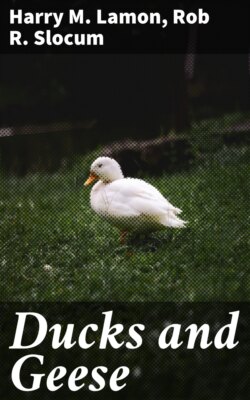Читать книгу Ducks and Geese - Rob R. Slocum - Страница 6
На сайте Литреса книга снята с продажи.
CHAPTER II
Breeds and Varieties—How to Mate to Produce Exhibition Specimens—Preparing Ducks for the Show—Catching and Handling
ОглавлениеTable of Contents
Breeds of Ducks. There are 11 standard breeds of ducks. All of these breeds with the exception of the Call, Muscovy and Runner consist of a single variety. The Call is divided into two varieties, the Gray and the White; the Muscovy consists of two varieties, the Colored and the White; and the Runner consists of three varieties, the Fawn and White, the White and the Penciled.
Duck breeders, of course, whether raising the birds for fancy or for profit, keep one of the standard breads or varieties. Frequently, also, the farm flocks consist of standardbred ducks but on many farms, probably a great majority, the flock consists of the common or so-called "puddle" duck. In certain parts of the South there is a duck known as the "mule duck" which is a cross between the Muscovy and the common duck. This is a duck of good market quality but will not breed from which characteristic it gets its name. Most of the common or "puddle" ducks which are found on farms are of rather small size, are indifferent as layers, and do not make a desirable type of market duck. They have arisen simply from the crossing of standard breeds with resultant carelessness and indifference in breeding. Because of the care with which they have been selected and bred for definite purposes, the standard breeds are decidedly superior to the common "puddle" ducks and should by all means be kept in preference since they will yield better results and greater profits.
In addition to the standard breeds and varieties flocks of Mallards are also kept to a limited extent. The Mallard is a common small wild duck which has lent itself readily to domestication and which thrives with proper care under confined conditions. In weight, the drakes will run from 2½ pounds to 3 pounds or even a little larger. The ducks average about 2¼ pounds with a variation of from 1 pound 12 ounces to 2 pounds 8 ounces. By selecting the large eggs for hatching and by liberal feeding, it is easy to increase the size of Mallards to such an extent that they resemble small Rouens rather than wild Mallards. The plumage of the Mallard is very similar to that of the Rouen but of a lighter shade. Another small wild duck known as the Wood or Carolina duck, which is a native of North America, has been domesticated and on account of the great beauty of its plumage is usually to be found wherever ornamental waterfowl are kept. The Mandarin duck is a small duck of about the same size as the Wood duck, is of beautiful plumage and like the Wood duck is generally kept for ornamental purposes. This duck is said to be a native of China.
Fig. 1. Upper—Pair of Mule Ducks. Lower—Pair of Blue Swedish Ducks. (Photographs from the Bureau of Animal Industry, U. S. Department of Agriculture.)
Fig. 2. Upper—Mallard Duck. Lower—Mallard Drake. The Mallard is a wild duck which is quite easily domesticated and which has a plumage color very similar to the Rouen. It is small in size. (Photographs from the Bureau of Animal Industry, U. S. Department of Agriculture.)
